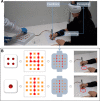Self-powered electro-tactile system for virtual tactile experiences
- PMID: 33536215
- PMCID: PMC7857682
- DOI: 10.1126/sciadv.abe2943
Self-powered electro-tactile system for virtual tactile experiences
Abstract
Tactile sensation plays important roles in virtual reality and augmented reality systems. Here, a self-powered, painless, and highly sensitive electro-tactile (ET) system for achieving virtual tactile experiences is proposed on the basis of triboelectric nanogenerator (TENG) and ET interface formed of ball-shaped electrode array. Electrostatic discharge triggered by TENG can induce notable ET stimulation, while controlled distance between the ET electrodes and human skin can regulate the induced discharge current. The ion bombardment technique has been used to enhance the electrification capability of triboelectric polymer. Accordingly, TENG with a contact area of 4 cm2 is capable of triggering discharge, leading to a compact system. In this skin-integrated ET interface, touching position and motion trace on the TENG surface can be precisely reproduced on skin. This TENG-based ET system can work for many fields, including virtual tactile displays, Braille instruction, intelligent protective suits, or even nerve stimulation.
Copyright © 2021 The Authors, some rights reserved; exclusive licensee American Association for the Advancement of Science. No claim to original U.S. Government Works. Distributed under a Creative Commons Attribution NonCommercial License 4.0 (CC BY-NC).
Figures





Similar articles
-
Triboelectric nanogenerators as new energy technology for self-powered systems and as active mechanical and chemical sensors.ACS Nano. 2013 Nov 26;7(11):9533-57. doi: 10.1021/nn404614z. Epub 2013 Oct 3. ACS Nano. 2013. PMID: 24079963
-
Restoring Tactile Sensation Using a Triboelectric Nanogenerator.ACS Nano. 2021 Jul 27;15(7):11087-11098. doi: 10.1021/acsnano.0c10141. Epub 2021 Jun 17. ACS Nano. 2021. PMID: 34137606 Free PMC article.
-
Fully Organic Self-Powered Electronic Skin with Multifunctional and Highly Robust Sensing Capability.Research (Wash D C). 2021 Feb 20;2021:9801832. doi: 10.34133/2021/9801832. eCollection 2021. Research (Wash D C). 2021. PMID: 33693434 Free PMC article.
-
On-Skin Triboelectric Nanogenerator and Self-Powered Sensor with Ultrathin Thickness and High Stretchability.Small. 2017 Dec;13(47). doi: 10.1002/smll.201702929. Epub 2017 Oct 23. Small. 2017. PMID: 29058800
-
Self-Powered Microfluidic Transport System Based on Triboelectric Nanogenerator and Electrowetting Technique.ACS Nano. 2018 Feb 27;12(2):1491-1499. doi: 10.1021/acsnano.7b08014. Epub 2018 Jan 22. ACS Nano. 2018. PMID: 29341585
Cited by
-
Neural interfaces: Bridging the brain to the world beyond healthcare.Exploration (Beijing). 2024 Mar 14;4(5):20230146. doi: 10.1002/EXP.20230146. eCollection 2024 Oct. Exploration (Beijing). 2024. PMID: 39439491 Free PMC article.
-
Digital channel-enabled distributed force decoding via small datasets for hand-centric interactions.Sci Adv. 2025 Jan 24;11(4):eadt2641. doi: 10.1126/sciadv.adt2641. Epub 2025 Jan 22. Sci Adv. 2025. PMID: 39841827 Free PMC article.
-
Resolving hyperelasticity-adhesiveness conflict in polymer networks by in situ constructing mechanical heterogeneities.Nat Commun. 2025 Jul 2;16(1):6094. doi: 10.1038/s41467-025-61450-5. Nat Commun. 2025. PMID: 40603317 Free PMC article.
-
Recent Advances in Flexible Tactile Sensors for Intelligent Systems.Sensors (Basel). 2021 Aug 10;21(16):5392. doi: 10.3390/s21165392. Sensors (Basel). 2021. PMID: 34450833 Free PMC article. Review.
-
Biomimetic Wearable Sensors: Emerging Combination of Intelligence and Electronics.Adv Sci (Weinh). 2024 Feb;11(5):e2303264. doi: 10.1002/advs.202303264. Epub 2023 Dec 3. Adv Sci (Weinh). 2024. PMID: 38044298 Free PMC article. Review.
References
-
- Matthews D., Virtual-reality applications give science a new dimension. Nature 557, 127–128 (2018). - PubMed
-
- Yu X., Xie Z., Yu Y., Lee J., Vazquez-Guardado A., Luan H., Ruban J., Ning X., Akhtar A., Li D., Ji B., Liu Y., Sun R., Cao J., Huo Q., Zhong Y., Lee C. M., Kim S. Y., Gutruf P., Zhang C., Xue Y., Guo Q., Chempakasseril A., Tian P., Lu W., Jeong J. Y., Yu Y. J., Cornman J., Tan C. S., Kim B. H., Lee K. H., Feng X., Huang Y., Rogers J. A., Skin-integrated wireless haptic interfaces for virtual and augmented reality. Nature 575, 473–479 (2019). - PubMed
-
- Sundaram S., Kellnhofer P., Li Y., Zhu J.-Y., Torralba A., Matusik W., Learning the signatures of the human grasp using a scalable tactile glove. Nature 569, 698–702 (2019). - PubMed
LinkOut - more resources
Full Text Sources
Other Literature Sources

